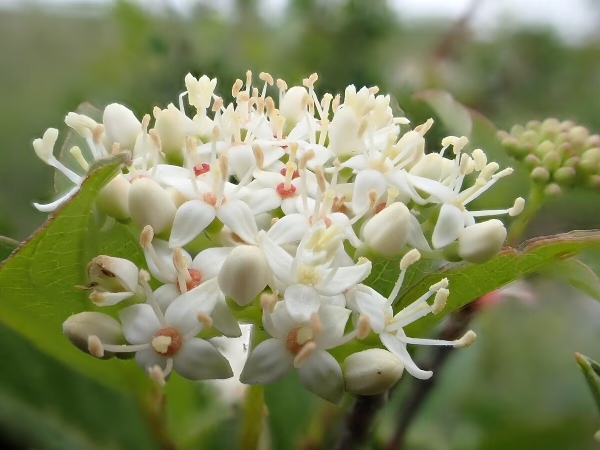
Red Osier Dogwood
Botanical Name
:
Cornus sericea
Plant Type
:
Deciduous shrub
Seasons
:
Plant in spring or fall; blooms in late spring to early summer
Sun Level
:
Full sun to partial shade; thrives best in at least 6 hours of sunlight daily
Ideal Soil Temperature for Planting
:
50 to 65°F (10°C to 18°C)
Soil Type
:
Loamy, well-draining soil; tolerates clay or sand
Hardiness Zones
:
3–7 (USDA)
Germination
:
4–12 weeks
P.H. Level
:
Slightly acidic to neutral (6.1 to 8.5)
Water/Irrigation
:
Requires regular watering, especially during dry periods; prefers wet soil conditions
Fertilization
:
Apply a balanced 10-10-10 fertilizer in early spring and mid-summer to promote healthy growth
Habit
:
Upright, spreading habit
Propagation
:
Seeds (but very slow) and cuttings taken in late fall or early winter
Final Plant Height
:
6–9 ft
Spread
:
8–12ft
Flowers
:
Small, frothy white flowers in large clusters
Attracts
:
Birds and butterflies
Uses
:
Provides year-round color in the landscape, used for basket weaving
Companions
:
Shrubs like ninebark, elderberry, viburnums, and willows; perennials such as asters, goldenrods, Joe-Pye weed, and coneflowers; grasses like switchgrass, little bluestem, and sedges; and various ferns
Pruning
:
Prune in late winter or early spring before new growth begins. Remove dead or damaged branches and thin out older stems to encourage new growth
Toxicity
:
Not toxic to pets or humans
Pests
:
Mites, scales, gnats, mealybugs, and aphids
Diseases
:
Fungal diseases like powdery mildew, leaf spots, and anthracnose, as well as other conditions like canker and root rot
Additional Info
:
Indigenous peoples of North America used the inner bark of red osier dogwood in various ways, including smoking mixtures (often called “kinnikinick”), dyes, and medicinal remedies
Botanical Name
:
Cornus sericea
Plant Type
:
Deciduous shrub
Seasons
:
Plant in spring or fall; blooms in late spring to early summer
Sun Level
:
Full sun to partial shade; thrives best in at least 6 hours of sunlight daily
Ideal Soil Temperature for Planting
:
50 to 65°F (10°C to 18°C)
Soil Type
:
Loamy, well-draining soil; tolerates clay or sand
Hardiness Zones
:
3–7 (USDA)
Germination
:
4–12 weeks
P.H. Level
:
Slightly acidic to neutral (6.1 to 8.5)
Water/Irrigation
:
Requires regular watering, especially during dry periods; prefers wet soil conditions
Fertilization
:
Apply a balanced 10-10-10 fertilizer in early spring and mid-summer to promote healthy growth
Habit
:
Upright, spreading habit
Propagation
:
Seeds (but very slow) and cuttings taken in late fall or early winter
Final Plant Height
:
6–9 ft
Spread
:
8–12ft
Flowers
:
Small, frothy white flowers in large clusters
Attracts
:
Birds and butterflies
Uses
:
Provides year-round color in the landscape, used for basket weaving
Companions
:
Shrubs like ninebark, elderberry, viburnums, and willows; perennials such as asters, goldenrods, Joe-Pye weed, and coneflowers; grasses like switchgrass, little bluestem, and sedges; and various ferns
Pruning
:
Prune in late winter or early spring before new growth begins. Remove dead or damaged branches and thin out older stems to encourage new growth
Toxicity
:
Not toxic to pets or humans
Pests
:
Mites, scales, gnats, mealybugs, and aphids
Diseases
:
Fungal diseases like powdery mildew, leaf spots, and anthracnose, as well as other conditions like canker and root rot
Additional Info
:
Indigenous peoples of North America used the inner bark of red osier dogwood in various ways, including smoking mixtures (often called “kinnikinick”), dyes, and medicinal remedies
Written by Nondiah Khalayi – https://www.linkedin.com/in/nondiah-khalayi/

